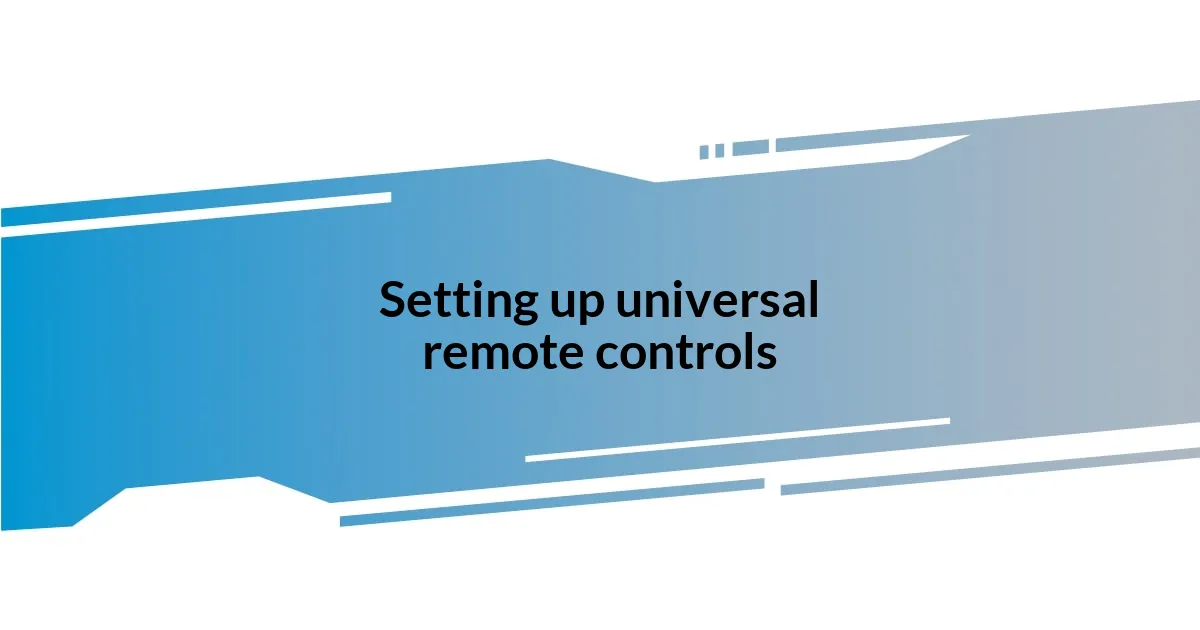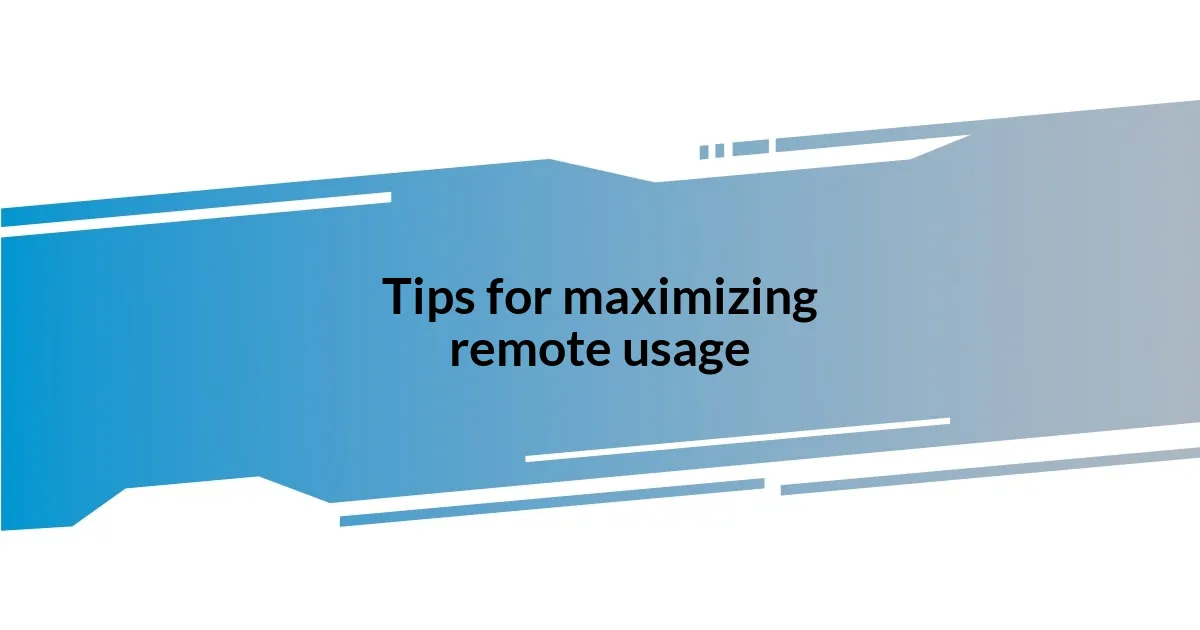Key takeaways:
- The journey of using universal remotes started with the frustration of managing multiple devices, leading to the discovery of their convenience.
- Programming remotes can be challenging, but persistence and online resources can simplify the process and enhance user experience.
- Choosing the right universal remote requires considering compatibility, ease of programming, features, design, and price.
- Organizing remotes and programming shortcuts can significantly improve usability and enjoyment during family movie nights.

My journey with universal remotes
My journey with universal remotes began during a chaotic family movie night. Picture this: snacks strewn everywhere, kids arguing over whose turn it was to choose a film, and me frantically hunting for four different remotes. That’s when I decided enough was enough and invested in my first universal remote. The joy of finally having one device do the work of four was an absolute relief!
I still remember the learning curve that came with programming it. There was quite a bit of trial and error, and let me tell you, nothing is quite as frustrating as the remote not syncing with the TV just when you’re finally settled in for a cozy night. But when I got it working? It felt like a small victory, like solving a puzzle I never knew I needed to solve. Have you ever experienced that rush when everything clicks into place? It was a moment that cemented my appreciation for user-friendly tech.
Over the years, I’ve had a few universal remotes come and go, each with their quirks and features. Some have been cutting-edge while others fell flat on their promises. I remember one time, a fancy model promised to control my lights and sound system, but it turned out to be more of a hassle than a help. Isn’t it funny how technology can both simplify and complicate our lives? This journey has made me cherish the ones that truly deliver on ease of use while also reminding me that sometimes, embracing simplicity is the best path forward.

Understanding universal remote controls
Understanding universal remote controls can be fascinating. These devices allow us to manage multiple gadgets using just one remote, which is a huge convenience. I remember the first time I seamlessly switched from my cable box to a streaming service with a single button. It felt like I had unlocked a hidden power!
The programming aspect can be a little daunting at first. I distinctly recall one evening when my remote refused to recognize my soundbar. After what felt like an eternity of pressing buttons and consulting the manual, joy flooded in when it finally worked. Have you ever had a moment where persistence pays off? That satisfaction solidified my respect for universal remotes, recognizing their potential to simplify our lives.
In comparing different types of universal remotes, it’s evident that they come in all shapes and sizes. Some are basic, while others offer advanced features, like voice commands or smart home integration. I once tried a high-end model that promised integration with my entire home system. While it was a massive leap in tech, the straightforward nature of a simple remote often won my heart. It’s like comparing a gourmet meal to a homemade favorite; both have their place, but simplicity sometimes wins.
| Type of Remote | Features |
|---|---|
| Basic Universal Remote | Control various devices, simple layout, easy to program |
| Advanced Universal Remote | Voice control, smart home integration, customizable buttons |

Choosing the right universal remote
Choosing the right universal remote can feel overwhelming with so many options available. I recall standing in the electronics aisle, staring at rows of remotes, each boasting unique features. It’s crucial to think about your specific needs, whether that’s programming various devices, ease of use for family members, or advanced functions like voice control. I’ve learned that sometimes my heart sinks when a supposedly intuitive remote proves anything but, packed with convoluted instructions.
When selecting a universal remote, consider these factors:
- Compatibility: Ensure it works with all your devices.
- Ease of Programming: Look for models with user-friendly setup processes.
- Features: Decide whether you need just basic functions or smart features like voice assistance.
- Design: Consider how it feels in your hand and whether the buttons are comfortably spaced.
- Price Point: Set a budget, as prices can range from affordable to premium.
Through my experiences, I discovered that it’s often worth spending a tad more for a remote that genuinely enhances your viewing experience. Once, a mid-range model exceeded my expectations, transforming chaotic evenings into harmonious family time. That feeling of effortless control is absolutely invaluable!

Setting up universal remote controls
Setting up a universal remote can seem a bit like assembling a puzzle, and I’ve definitely had my share of struggles. The first time I tried it, I remember staring blankly at the instructions, feeling a mix of determination and frustration. Once I finally powered through it, though, I felt a wave of relief wash over me. Have you ever experienced that moment when everything just clicks into place?
One effective method I found is to tackle the setup step by step. I always start by connecting one device at a time, which simplifies the process. I vividly recall the sense of accomplishment I felt when I linked my TV first—seeing the device respond was like opening a gift I didn’t know I wanted. Plus, it’s incredibly rewarding to witness the functionality evolve as each device is added.
Don’t underestimate the power of online resources, either. While my initial setup was challenging, a quick search led me to forums filled with tips and tricks from fellow users. One suggestion that truly helped me was resetting the remote completely when it failed to connect; it was a simple fix that opened a door to smoother programming. Have you ever found a community that made your experience easier? Connecting with others enriched my understanding and made the process feel less intimidating.

Troubleshooting common remote issues
I recognize that troubleshooting remote issues can be a frustrating experience. There have been a few times when my remote just wouldn’t respond, and I felt as if the world had come to a halt. If your remote is not functioning, the first thing I recommend is checking the batteries. It’s such a simple step, yet I often overlook it in my quest for a more complex solution. During one particular movie night, I learned this lesson the hard way—my friends were ready to watch, and I was left scrambling for fresh batteries.
Another common issue I’ve encountered is when the remote seems to control only certain functions, leaving me to navigate a maze of buttons. In one case, I remember trying to adjust the volume, but instead, I turned the TV off! To resolve that, I took a deep breath and reassessed the programming. Sometimes, recalibrating the remote by re-syncing it with the device can make all the difference. Have you ever found that just a small reset can lead to a complete turnaround? I certainly have, and that moment of triumph is priceless.
Then, there are those times when the remote simply refuses to pair with a new device. I once bought a soundbar and was eager to use my universal remote—but nothing happened. After a bit of research, I discovered the importance of checking for updated device codes. Trust me; I felt like a detective piecing together clues. If you find yourself in this situation, don’t hesitate to consult the manual or online guides for the correct codes. That “aha!” moment when it finally works? It’s worth every bit of hassle!

Tips for maximizing remote usage
I’ve found that organizing my remotes and the devices they control is a game changer. When I discovered a small basket to hold my remotes, it was like finding the missing piece to a jigsaw puzzle. Everything felt more cohesive, and I could easily grab the right remote without digging through a pile of chaos. Have you ever experienced that satisfaction of a well-organized space? It truly makes using a universal remote more enjoyable.
Another tip I swear by is programming shortcuts for frequently used functions. The first time I mapped the “mute” button to an easy-to-access spot, I felt like a genius. It drastically reduced the time I spent fumbling around during intense movie moments—especially when I had to shush the dog! Quick access to your favorite channels or functions means less hassle and more enjoyment. Why struggle when you can simplify?
Lastly, I recommend keeping a small notepad handy to jot down any quirks or settings that work for your specific devices. For instance, I once wrote down the precise order of my TV and soundbar setup, which saved me so much time. Instead of retracing my steps each time I needed to reconnect, I had my own personalized guide. Have you ever wished you had a reference for an easy process? Trust me, those notes might just become your lifesaver on busy movie nights.